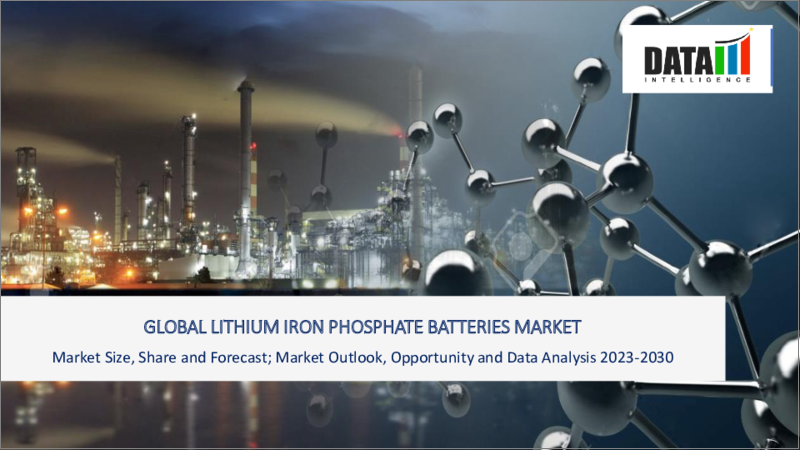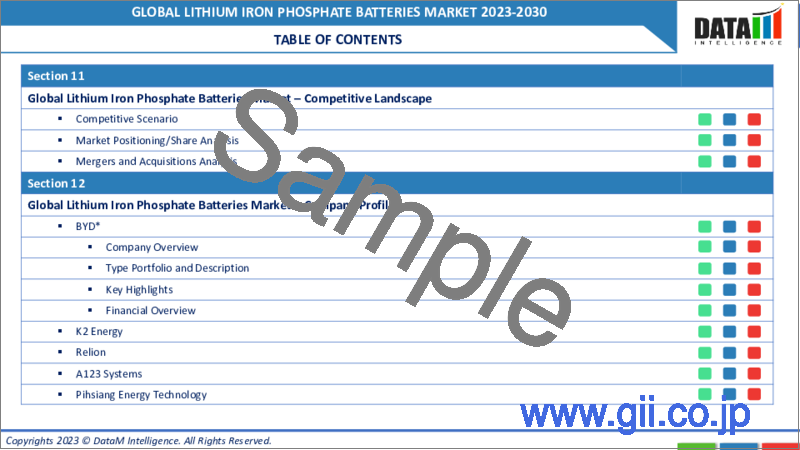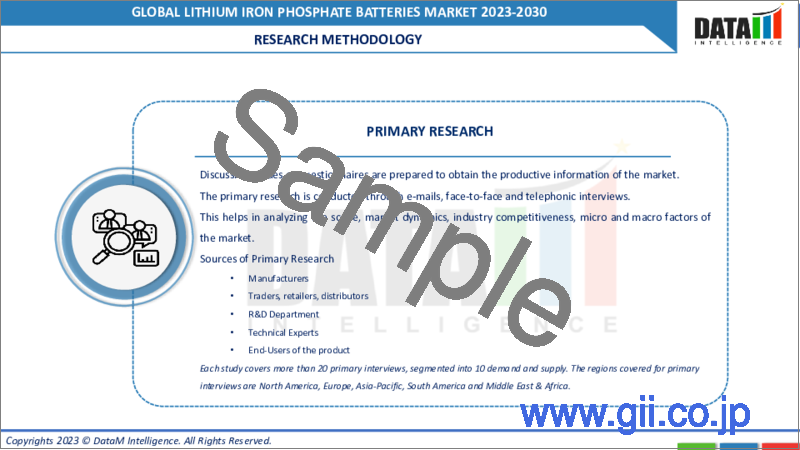|
|
市場調査レポート
商品コード
1304531
リン酸鉄リチウムバッテリーの世界市場-2023年~2030年Global Lithium Iron Phosphate Batteries Market - 2023-2030 |
||||||
|
● お客様のご希望に応じて、既存データの加工や未掲載情報(例:国別セグメント)の追加などの対応が可能です。 詳細はお問い合わせください。 |
|||||||
| リン酸鉄リチウムバッテリーの世界市場-2023年~2030年 |
|
出版日: 2023年07月07日
発行: DataM Intelligence
ページ情報: 英文 195 Pages
納期: 約2営業日
|
- 全表示
- 概要
- 目次
市場概要
世界のリン酸鉄リチウムバッテリー市場は、2022年に122億米ドルに達し、2023~2030年の予測期間中にCAGR 12.5%で成長し、2030年には313億米ドルに達すると予測されます。再生可能エネルギープロジェクトの成長は、中期的にリン酸鉄リチウムバッテリーの需要を促進する重要な要因です。
再生可能エネルギーにおけるリン酸鉄リチウムバッテリーの需要ダイナミクスも変化し、需要の大半は発展途上国からもたらされると予想されます。例えば、2023年5月、インドの国営石油・ガス会社であるONGCは、アッサム州のディスコムと合弁契約を結び、同州で500MWhの蓄電池プロジェクトを建設・運営します。
リン酸鉄リチウムバッテリーメーカーも、よりエネルギー密度の高い新しい電池を開発しています。例えば、米国の新興電池メーカーであるゴティオン・ハイテックは2023年5月、リン酸鉄リチウムバッテリーL600を発表しました。この高エネルギー密度バッテリーは、1回の充電で621マイルの航続距離を実現できます。
市場力学
マイクログリッドとオフグリッドシステムの成長
マイクログリッドとオフグリッドシステムは、主要な電力網へのアクセスが制限されている、またはない地域で信頼性の高い電力供給を行うために設計されています。マイクログリッドの採用は、政府が大規模な電化推進に取り組む中、低開発国や発展途上国で拡大しています。さらにマイクログリッドは、先進国の遠隔地にある人間の居住区への電力供給にも利用されています。
エネルギー密度が高く、さまざまな温度範囲で作動し、急速充放電が可能なリン酸鉄リチウムバッテリーは、マイクログリッドにエネルギー貯蔵とバックアップ電力を供給する魅力的な選択肢となっています。メーカー各社はまた、特にオフグリッドでの使用を目的とした新しいバッテリーを発売しています。2023年2月、米国の電池メーカーであるディスカバリー・バッテリーは、オフグリッド用の100Ahリン酸鉄リチウムバッテリーを発売しました。
有利な政府政策とインセンティブ
世界中の政府や規制機関は、電気自動車の利用を促進するための支援政策やインセンティブを実施しています。こうした取り組みには、補助金、税制優遇措置、助成金などが含まれ、電気自動車を消費者にとってより購入しやすいものにし、メーカーがリン酸鉄リチウムのようなバッテリー技術に投資することを後押ししています。
2022年11月、欧州連合(EU)は新しい電池技術の研究開発のための32億ユーロ(34億米ドル)の基金を発表しました。さらに、米国エネルギー省(DOE)は2023年1月、商業用途の二次電池技術の基礎・先端研究のために1億2,500万米ドルを助成すると発表しました。
他の電池化学との競合
リン酸鉄リチウムバッテリーはエネルギー密度が高いが、ニッケル・コバルト・アルミニウム酸化リチウム(NCA)やニッケル・マンガン・コバルト酸化リチウム(NMC)のような他の電池化学はエネルギー密度が高く、電気自動車のような用途でより長い走行距離と長持ちする電力を可能にします。リン酸鉄リチウムバッテリーは一般的に、他のリチウムイオン電池化学物質よりも充電速度が遅いです。
電気自動車のような急速充電を必要とする用途では、チタン酸リチウム(LTO)や特定の高ニッケルNMC化学物質のような、より高速充電の代替品が好まれる場合があります。電池技術は絶えず進化しており、新しい化学物質が研究されています。他の電池化学の改善により、リン酸鉄リチウムバッテリーの需要が減少する可能性があります。
COVID-19影響分析
COVID-19パンデミックは、リン酸鉄リチウムバッテリー市場にプラスとマイナスの影響を与えました。当初、パンデミックは世界のサプライチェーンを混乱させ、リン酸鉄リチウムバッテリーの生産と流通に関わる製造と物流の課題につながっています。しかし、世界がパンデミックから脱却すると、再生可能エネルギーと持続可能なソリューションへの注目が高まっています。
広範な経済回復計画の一環であるクリーンエネルギーに対する政府の優遇措置と投資は、電気自動車、エネルギー貯蔵、再生可能エネルギーシステムなどの分野でリン酸鉄リチウムバッテリーの需要を加速させました。パンデミックはリン酸鉄リチウムバッテリー市場の成長に弾みをつけた。
AIの影響
人工知能はリン酸鉄リチウムバッテリー市場に大きな影響を与える可能性があります。AIを搭載した技術は、電池性能を最適化し、充電効率を高め、電池寿命を延ばすことができます。AIはインテリジェントな電池管理システムとアルゴリズムを通じてリン酸鉄リチウムバッテリーをリアルタイムで監視・制御し、その使用量を最適化してシステム全体の性能を向上させることができます。
また、AIを活用した予測分析によってバッテリー管理を強化し、バッテリーの健全性、充電状態、劣化の正確な推定を可能にします。これは、リン酸鉄リチウムバッテリーのより効果的なメンテナンスと利用につながります。AI主導の進歩により、リン酸鉄リチウムバッテリーの競争力が強化され、さまざまな用途で採用されることが期待されます。
ウクライナとロシアの影響
ウクライナ・ロシア戦争をきっかけに、欧州をはじめとする西側諸国はエネルギー供給を見直しました。この紛争は欧州のエネルギー価格の高騰につながり、欧州のリン酸鉄リチウムバッテリーメーカーの競争力を低下させる可能性が高いです。この戦争は、アジア太平洋地域の電池メーカーにとって、市場シェア拡大の大きなチャンスとなります。
EUは、クリーンな輸送手段を含むグリーン経済を推進するため、さまざまな政策に取り組んできました。2023年3月、EUは2035年からゼロ・エミッション車のみを域内で販売することを認める新政策を可決しました。戦後の最近の政府の政策は、リン酸鉄リチウムバッテリーの需要を増大させると思われます。
目次
第1章 調査手法と調査範囲
第2章 定義と概要
第3章 エグゼクティブサマリー
第4章 市場力学
- 影響要因
- 促進要因
- 電気自動車(EV)の価格下落
- グリッド規模エネルギー貯蔵ソリューションの採用増加
- マイクログリッドとオフグリッドシステムの成長
- 有利な政府政策とインセンティブ
- 抑制要因
- 世界のリチウム生産量の不足
- 他の電池化学との競合
- 機会
- 影響分析
- 促進要因
第5章 産業分析
- ポーターのファイブフォース分析
- サプライチェーン分析
- 価格分析
- 規制分析
第6章 COVID-19分析
第7章 タイプ別
- 携帯型
- 据え置き型
第8章 容量別
- 0~16,250Mah
- 16,251~50,000Mah
- 50,001-100,000Mah
- 100,001~540,000Mah
第9章 用途別
- 自動車
- 電力
- 産業
- その他
第10章 地域別
- 北米
- 米国
- カナダ
- メキシコ
- 欧州
- ドイツ
- 英国
- フランス
- イタリア
- スペイン
- その他欧州
- 南米
- ブラジル
- アルゼンチン
- その他南米
- アジア太平洋
- 中国
- インド
- 日本
- オーストラリア
- その他アジア太平洋地域
- 中東・アフリカ
第11章 競合情勢
- 競合シナリオ
- 市況/シェア分析
- M&A分析
第12章 企業プロファイル
- BYD
- 会社概要
- 製品ポートフォリオと説明
- 財務概要
- 主な発展
- K2 Energy
- Relion
- A123 Systems
- Pihsiang Energy Technology
- Lithium Werks
- Optimumnano Energy
- Taico
- Victron Energy
- Contemporary Amperex Technology
第13章 付録
Market Overview
The Global Lithium Iron Phosphate Batteries Market reached US$ 12.2 billion in 2022 and is expected to reach US$ 31.3 billion by 2030, growing with a CAGR of 12.5% during the forecast period 2023-2030. The growth of renewable energy projects will be a key factor in driving the demand for lithium iron phosphate batteries in the medium term.
The demand dynamics for lithium iron phosphate batteries in renewable energy are also expected to change, with most of the demand coming from developing countries. For instance, in May 2023, ONGC, India's state-owned oil and gas company, signed a joint venture agreement with the discom of Assam to build and operate a 500 MWh battery storage project in the state.
Lithium Iron Phosphate Battery Manufacturers are also developing new, more energy-dense batteries. For instance, in May 2023, Gotion High Tech, a U.S. startup battery manufacturer, unveiled its L600 lithium iron phosphate battery. This high-energy density battery could provide 621 miles of range on a single charge.
Market Dynamics
Growth of Microgrid and Off-Grid Systems
Microgrid and off-grid systems are designed to provide reliable power supply in areas with limited or no access to the main electricity grid. Microgrid adoption has grown in underdeveloped and developing countries as governments undertake major electrification drives. Furthermore, microgrids are also used to power human settlements in remote regions of developed countries.
The high energy density, ability to work across various temperature ranges and quick charging and discharging capabilities make lithium iron phosphate batteries an attractive choice for providing energy storage and backup power in microgrids. Manufacturers are also launching new batteries specifically aimed at off-grid usage. In February 2023, Discovery Battery, a U.S.-based battery maker, launched a 100Ah lithium iron phosphate battery for off-grid usage.
Favorable Government Policies and Incentives
Governments and regulatory bodies across the globe are implementing supportive policies and incentives to promote the use of electric vehicles. The initiatives include subsidies, tax incentives, and grants, which make electric vehicles more affordable for consumers and encourage manufacturers to invest in battery technologies like lithium iron phosphate.
In November 2022, the European Union (EU) announced 3.2 billion euros (US$ 3.4 billion) fund for research and development of new battery technologies. Furthermore, in January 2023, the U.S. Department of energy (DOE) announced a US$ 125 million grant for basic and advanced research on rechargeable battery technologies for commercial applications.
Competition from Other Battery Chemistries
Although lithium iron phosphate batteries offer high energy density, other battery chemistries like lithium nickel cobalt aluminum oxide (NCA) and lithium nickel manganese cobalt oxide (NMC) offer higher energy density, allowing for longer-range and longer-lasting power in applications such as electric vehicles. Lithium iron phosphate batteries generally have slower charging rates than other lithium-ion battery chemistries.
For applications that require rapid charging, such as electric vehicles, faster-charging alternatives like lithium titanate (LTO) or specific high-nickel NMC chemistries may be preferred. The landscape of battery technologies is continuously evolving, with new chemistries being researched. Improvements in other battery chemistries may reduce the demand for lithium-iron phosphate batteries.
COVID-19 Impact Analysis
The COVID-19 pandemic has positively and negatively affected the Lithium Iron Phosphate Batteries Market. Initially, the pandemic disrupted global supply chains, leading to manufacturing and logistical challenges involving the production and distribution of lithium iron phosphate batteries. However, as the world emerged from the pandemic, there was an increased focus on renewable energy and sustainable solutions.
Government incentives and investments in clean energy, part of a broad-based economic recovery plan, have accelerated the demand for lithium iron phosphate batteries in sectors such as electric vehicles, energy storage, and renewable energy systems. The pandemic has provided a fillip to the growth of the Lithium Iron Phosphate Batteries Market.
AI Impact
Artificial intelligence can potentially impact the lithium iron phosphate batteries market significantly. AI-powered technologies can optimize battery performance, enhance charging efficiency, and extend battery lifespan. AI can monitor and control lithium iron phosphate batteries in real-time through intelligent battery management systems and algorithms, optimizing their usage and improving overall system performance.
AI-driven predictive analytics can also enhance battery management, enabling accurate estimation of battery health, state of charge, and degradation. This leads to more effective maintenance and utilization of lithium iron phosphate batteries. AI-driven advancements are expected to enhance the competitiveness and adoption of lithium iron phosphate batteries in various applications.
Ukraine-Russia Impact
European and other Western countries reoriented their energy supplies in the wake of the Ukraine-Russia war. Sanctions were imposed on Russia by the EU and the U.S. The conflict has led to high energy prices in Europe, likely eroding the competitiveness of European Lithium-Iron Phosphate Battery Manufacturers. The war thus provides major opportunities for battery manufacturers from Asia-Pacific to expand their market share.
EU has undertaken various policies to promote the green economy, including clean transportation. In March 2023, the EU passed a new policy allowing only zero-emission cars to be sold in the region from 2035. Recent governmental policies after the war will likely augment lithium iron phosphate battery demand.
Segment Analysis
The Global Lithium Iron Phosphate Batteries Market is segmented based on type, capacity, application and region.
Due to Wide-Ranging Applications, Stationary Batteries are More Widely Used
Stationary lithium iron phosphate batteries have higher energy density and can be used for wide-ranging applications requiring a constant power supply. It is most commonly used to power electric motors in EVs. Furthermore, the demand for stationary batteries is likely to increase with the increasing adoption of energy storage systems in conjunction with renewable energy.
Portable lithium iron phosphate batteries are mainly used for industrial automation systems and robotics. The batteries haven't found significant adoption in electronic devices, where lithium-ion batteries are most preferred. However, with new innovations, portable lithium iron phosphate batteries will likely find more applications in the upcoming years.
Geographical Analysis
Strong Government Policies Enable North America to Garner Major Market Share
North America occupies a share of nearly a quarter of the Global Lithium Iron Phosphate Batteries Market. Electric vehicle (EV) sales in North America have been buoyed by strong consumer demand and new government policies. More than 750,000 all-electric vehicles were sold in the U.S. in 2022, representing a 57% increase compared to 2021.
The U.S. government passed the inflation reduction act (IRA) in August 2022, which included several provisions for electric vehicles. For instance, the show consists of a 30% federal tax credit for EV charging infrastructure. The act has also allocated more than US$ 13 billion in incentives for automakers to increase electric vehicle production. The government policies will increase battery demand over the medium and long term.
Competitive Landscape
The major global players include: BYD, K2 Energy, Relion, A123 Systems, Pihsiang Energy Technology, Lithium Werks, Optimumnano Energy, Taico, Victron Energy and Contemporary Amperex Technology.
Why Purchase the Report?
- To visualize the Global Lithium Iron Phosphate Batteries Market segmentation based on type, capacity, application and region and understand key commercial assets and players.
- Identify commercial opportunities by analyzing trends and co-development.
- Excel data sheet with numerous data points of lithium iron phosphate batteries market-level with all segments.
- PDF report consists of a comprehensive analysis after exhaustive qualitative interviews and an in-depth study.
- Product mapping available as Excel consisting of key products of all the major players.
The Global Lithium Iron Phosphate Batteries Market Report Would Provide Approximately 57 Tables, 58 Figures And 195 Pages.
Target Audience 2023
- Manufacturers/ Buyers
- Industry Investors/Investment Bankers
- Research Professionals
- Emerging Companies
Table of Contents
1. Methodology and Scope
- 1.1. Research Methodology
- 1.2. Research Objective and Scope of the Report
2. Definition and Overview
3. Executive Summary
- 3.1. Snippet by Type
- 3.2. Snippet by Capacity
- 3.3. Snippet by Application
- 3.4. Snippet by Region
4. Dynamics
- 4.1. Impacting Factors
- 4.1.1. Drivers
- 4.1.1.1. Falling Prices of Electric Vehicles (EVs)
- 4.1.1.2. Rising Adoption of Grid-Scale Energy Storage Solutions
- 4.1.1.3. Growth of Microgrid and Off-Grid Systems
- 4.1.1.4. Favorable Government Policies and Incentives
- 4.1.2. Restraints
- 4.1.2.1. Shortfall in Global Lithium Production
- 4.1.2.2. Competition from Other Battery Chemistries
- 4.1.3. Opportunity
- 4.1.4. Impact Analysis
- 4.1.1. Drivers
5. Industry Analysis
- 5.1. Porter's Five Force Analysis
- 5.2. Supply Chain Analysis
- 5.3. Pricing Analysis
- 5.4. Regulatory Analysis
6. COVID-19 Analysis
- 6.1. Analysis of COVID-19
- 6.1.1. Scenario Before COVID
- 6.1.2. Scenario During COVID
- 6.1.3. Scenario Post COVID
- 6.2. Pricing Dynamics Amid COVID-19
- 6.3. Demand-Supply Spectrum
- 6.4. Government Initiatives Related to the Market During Pandemic
- 6.5. Manufacturers Strategic Initiatives
- 6.6. Conclusion
7. By Type
- 7.1. Introduction
- 7.1.1. Market Size Analysis and Y-o-Y Growth Analysis (%), By Type
- 7.1.2. Market Attractiveness Index, By Type
- 7.2. Portable*
- 7.2.1. Introduction
- 7.2.2. Market Size Analysis and Y-o-Y Growth Analysis (%)
- 7.3. Stationary
8. By Capacity
- 8.1. Introduction
- 8.1.1. Market Size Analysis and Y-o-Y Growth Analysis (%), By Capacity
- 8.1.2. Market Attractiveness Index, By Capacity
- 8.2. 0-16,250 Mah*
- 8.2.1. Introduction
- 8.2.2. Market Size Analysis and Y-o-Y Growth Analysis (%)
- 8.3. 16,251-50,000 Mah
- 8.4. 50,001-100,000 Mah
- 8.5. 100,001-540,000 Mah
9. By Application
- 9.1. Introduction
- 9.1.1. Market Size Analysis and Y-o-Y Growth Analysis (%), By Application
- 9.1.2. Market Attractiveness Index, By Application
- 9.2. Automotive*
- 9.2.1. Introduction
- 9.2.2. Market Size Analysis and Y-o-Y Growth Analysis (%)
- 9.3. Power
- 9.4. Industrial
- 9.5. Others
10. By Region
- 10.1. Introduction
- 10.1.1. Market Size Analysis and Y-o-Y Growth Analysis (%), By Region
- 10.1.2. Market Attractiveness Index, By Region
- 10.2. North America
- 10.2.1. Introduction
- 10.2.2. Key Region-Specific Dynamics
- 10.2.3. Market Size Analysis and Y-o-Y Growth Analysis (%), By Type
- 10.2.4. Market Size Analysis and Y-o-Y Growth Analysis (%), By Capacity
- 10.2.5. Market Size Analysis and Y-o-Y Growth Analysis (%), By Operation
- 10.2.6. Market Size Analysis and Y-o-Y Growth Analysis (%), By Application
- 10.2.7. Market Size Analysis and Y-o-Y Growth Analysis (%), By Country
- 10.2.7.1. The U.S.
- 10.2.7.2. Canada
- 10.2.7.3. Mexico
- 10.3. Europe
- 10.3.1. Introduction
- 10.3.2. Key Region-Specific Dynamics
- 10.3.3. Market Size Analysis and Y-o-Y Growth Analysis (%), By Type
- 10.3.4. Market Size Analysis and Y-o-Y Growth Analysis (%), By Capacity
- 10.3.5. Market Size Analysis and Y-o-Y Growth Analysis (%), By Application
- 10.3.6. Market Size Analysis and Y-o-Y Growth Analysis (%), By Country
- 10.3.6.1. Germany
- 10.3.6.2. The UK
- 10.3.6.3. France
- 10.3.6.4. Italy
- 10.3.6.5. Spain
- 10.3.6.6. Rest of Europe
- 10.4. South America
- 10.4.1. Introduction
- 10.4.2. Key Region-Specific Dynamics
- 10.4.3. Market Size Analysis and Y-o-Y Growth Analysis (%), By Type
- 10.4.4. Market Size Analysis and Y-o-Y Growth Analysis (%), By Capacity
- 10.4.5. Market Size Analysis and Y-o-Y Growth Analysis (%), By Application
- 10.4.6. Market Size Analysis and Y-o-Y Growth Analysis (%), By Country
- 10.4.6.1. Brazil
- 10.4.6.2. Argentina
- 10.4.6.3. Rest of South America
- 10.5. Asia-Pacific
- 10.5.1. Introduction
- 10.5.2. Key Region-Specific Dynamics
- 10.5.3. Market Size Analysis and Y-o-Y Growth Analysis (%), By Type
- 10.5.4. Market Size Analysis and Y-o-Y Growth Analysis (%), By Capacity
- 10.5.5. Market Size Analysis and Y-o-Y Growth Analysis (%), By Application
- 10.5.6. Market Size Analysis and Y-o-Y Growth Analysis (%), By Country
- 10.5.6.1. China
- 10.5.6.2. India
- 10.5.6.3. Japan
- 10.5.6.4. Australia
- 10.5.6.5. Rest of Asia-Pacific
- 10.6. Middle East and Africa
- 10.6.1. Introduction
- 10.6.2. Key Region-Specific Dynamics
- 10.6.3. Market Size Analysis and Y-o-Y Growth Analysis (%), By Type
- 10.6.4. Market Size Analysis and Y-o-Y Growth Analysis (%), By Capacity
- 10.6.5. Market Size Analysis and Y-o-Y Growth Analysis (%), By Application
11. Competitive Landscape
- 11.1. Competitive Scenario
- 11.2. Market Positioning/Share Analysis
- 11.3. Mergers and Acquisitions Analysis
12. Company Profiles
- 12.1. BYD*
- 12.1.1. Company Overview
- 12.1.2. Product Portfolio and Description
- 12.1.3. Financial Overview
- 12.1.4. Key Developments
- 12.2. K2 Energy
- 12.3. Relion
- 12.4. A123 Systems
- 12.5. Pihsiang Energy Technology
- 12.6. Lithium Werks
- 12.7. Optimumnano Energy
- 12.8. Taico
- 12.9. Victron Energy
- 12.10. Contemporary Amperex Technology
LIST NOT EXHAUSTIVE
13. Appendix
- 13.1. About Us and Services
- 13.2. Contact Us




